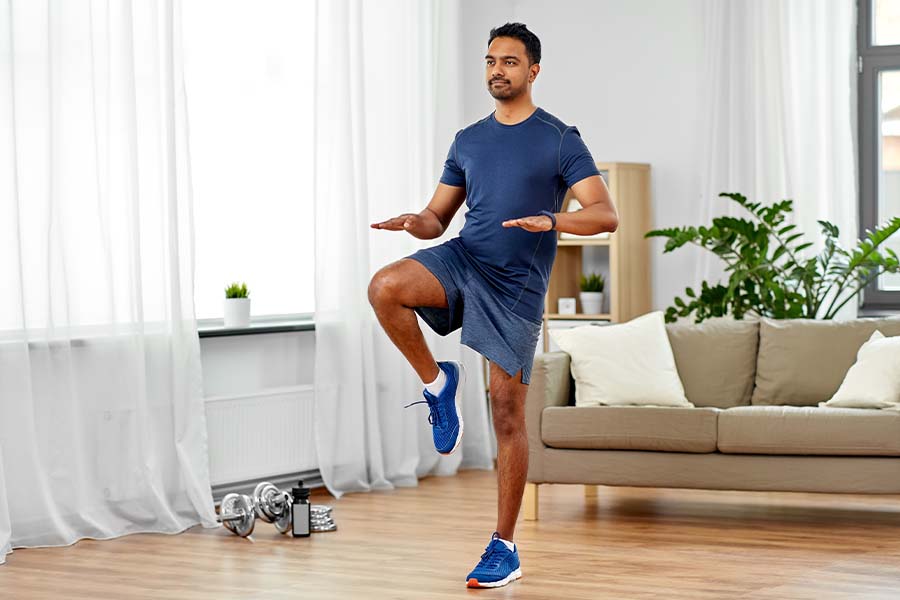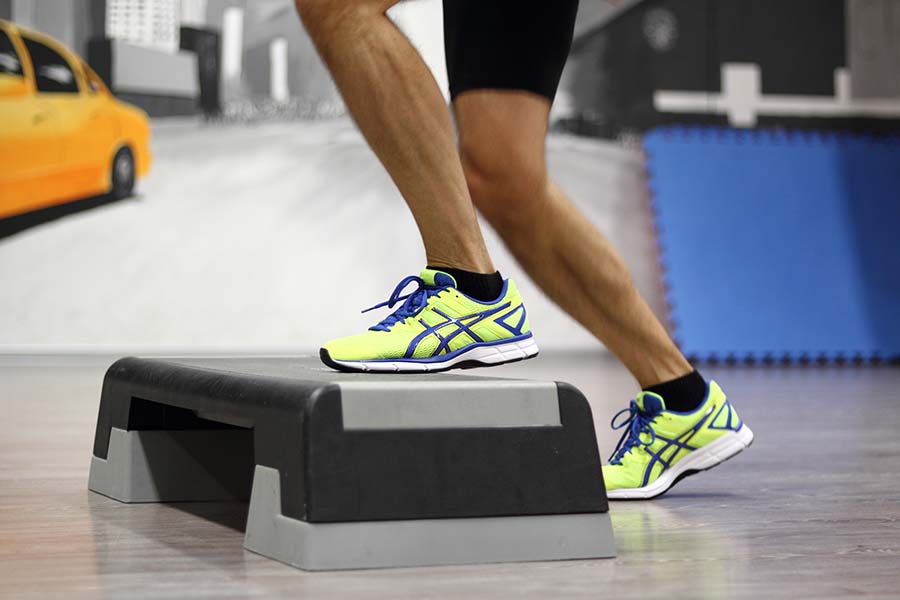Obesity is a chronic medical condition characterized by excessive body fat that can lead to various health problems, such as high blood pressure, type 2 diabetes, heart disease, and stroke. Obesity has become a global epidemic, with nearly 2 billion adults overweight and 650 million obese worldwide.
Obese individuals often face barriers to regular physical activity, including limited mobility and joint pain, making exercising challenging. However, regular physical activity is crucial for weight management, improving cardiovascular health, boosting mood and energy levels, and reducing the risk of chronic diseases.
Fortunately, exercising at home can provide a convenient and comfortable option for obese individuals to start incorporating physical activity into their daily routines. We will discuss seven effective exercises for obese beginners to try at home, precautions to consider before starting, how to incorporate these exercises into a routine, and additional tips for success.
Related Article: Top 25 At-Home Exercises for Beginners
Precautions to Consider Before Starting
Starting an exercise program can be intimidating, especially for individuals who are obese or have health concerns, and it's crucial to take certain precautions to minimize the risk of injury and ensure safety. Here are some precautions to consider before starting an exercise routine:
Consulting With a Physician
Before beginning an exercise program, it's essential to consult with a healthcare professional.
A physician can provide valuable guidance on the safe and appropriate exercise types for you. They can also recommend modifications or adaptations to exercises that can accommodate your needs.
Starting Slow and Gradually Increasing Intensity
It's important to start with low-intensity exercises and gradually increase the intensity as your fitness level improves. Starting slow and steady can help prevent injury, reduce soreness, and make exercising more manageable. Over time, you can gradually increase the duration and intensity of the exercise.
Listening to Your Body
Pay attention to your body's cues and stop exercising immediately if you experience pain, discomfort, or shortness of breath. Resting when needed is important to prevent injury and promote recovery. If you experience chest pain, dizziness, or other unusual symptoms, stop exercising immediately and seek medical attention.
Warming Up and Cooling Down
It's essential to warm up before exercising by stretching and performing low-intensity exercises to prepare your body for the workout. Similarly, cooling down by stretching after exercising can help reduce soreness and prevent injury. A proper warm-up and cool-down routine can help improve flexibility, increase blood flow, and reduce the risk of injury.
By taking these precautions, you can ensure a safe and effective exercise routine that can help you achieve your fitness goals. It's also important to remember that physical activity should be enjoyable, and you should never push yourself beyond your limits. Listen to your body and take it one step at a time.
Related Article: 25 Most Effective Stretches to Do Before Exercising
Effective Exercises for Obese Beginners at Home
Exercising has many health benefits, such as strengthening bones and muscles, and promoting mental health. For obese individuals, starting an exercise program can be challenging, but multiple exercises can be done at home without any equipment. Here are seven effective exercises for obese beginners to try at home:
1. Walking

Walking is an excellent low-impact exercise that you can do anywhere, indoors or outdoors. Walking can improve cardiovascular health, boost energy levels, reduce stress, and burn calories. You can also use a fat burner to burn calories.
- To do it, put on comfortable shoes and start slowly and steadily.
- Gradually increase the duration of the walk by increasing the speed or incline.
- It's essential to warm up before walking and cool down afterward to avoid injury.
- Walking for at least 30 minutes daily, five days a week, can provide significant health benefits.
2. Chair Squats

Chair squats are an excellent exercise for building strength in the legs and glutes. Squats can help improve balance, flexibility, and bone density.
- To do it, sit in a sturdy chair with your feet hip-width apart.
- Lean slightly forward and engage your core muscles as you stand up slowly.
- Keep your knees over your ankles and your weight in your heels.
- Sit back down slowly, and repeat for several repetitions.
- Try holding some weight or a water bottle in each hand to increase the intensity.
- Perform 2 sets of 10-15 repetitions.
3. Knee Raises

Knee raises are an effective exercise for strengthening the core and lower body. Knee raises can improve balance, stability, and coordination.
- To do it, stand behind a chair and hold onto the backrest.
- Lift one knee towards your chest, hold for a few seconds if you can, and then lower it down.
- Repeat on the other side.
- Keep your back straight and engage your core muscles throughout the exercise.
- Perform 2 sets of 10-15 repetitions on each side.
4. Standing Calf Raises

Standing calf raises are an excellent exercise for strengthening the calves. Calf raises can help improve balance, flexibility, and ankle mobility. You can use a foot and leg stretcher for gymnastics to stretch and strengthen your ankles, hamstrings, and calves.
- To do it, stand with your feet hip-width apart and raise up onto your toes.
- Then slowly lower back down.
- Repeat for several repetitions.
- Try holding a weight or a water bottle in each hand to increase the intensity.
5. Wall Push-Ups

Wall push-ups are an effective upper-body exercise that can be easily done at home. Push-ups can help improve upper body strength, posture, and bone density.
- To do it, stand facing a wall with your hands on it, shoulder-width apart.
- Step back a few steps so that your body is at an angle.
- Bend your elbows and lower your chest towards the wall, then push back up.
- Perform 3 sets of 10-15 repetitions.
6. Step-Ups

Step-ups are an effective exercise for building strength in the legs and glutes. Step-ups can help improve balance, coordination, and bone density.
- To do it, stand in front of a step or sturdy platform and step up with one foot, then bring the other foot up to meet it.
- Step back down and repeat on the other side.
- Keep your back straight and engage your core muscles throughout the exercise.
- Perform 15 repetitions on each side.
7. Plank

Planks are an effective core exercise that can be done at home. Planks can help improve core strength, stability, and posture.
- To do it, start in a push-up position, then lower down onto your forearms.
- Keep your body straight and hold the position for as long as possible.
- Hold the plank for at least 30 seconds and gradually increase the duration over time.
- Keeping your back straight and engaging your core muscles throughout the exercise is important.
These exercises can be modified or adapted to accommodate individual needs or limitations. It's essential to start with comfortable and manageable exercises and gradually increase the intensity and duration over time. Incorporating these exercises into a regular exercise routine can help obese individuals improve their health, fitness, and quality of life.
How to Incorporate These Exercises Into a Routine
Starting an exercise program can be challenging, especially for obese individuals. Setting realistic goals, creating a schedule, tracking progress, and staying motivated is essential to ensure success. Here's how to incorporate these exercises into a routine:
Setting Realistic Goals
Setting realistic goals is essential for staying motivated and achieving success. Begin by establishing realistic and attainable goals, such as working out for 10 minutes daily or taking a walk around the neighborhood. Gradually increase the intensity of your exercises as you get more accustomed to them. Be sure to celebrate your achievements, no matter how small they may seem.
Creating a Schedule
Creating a schedule is vital for establishing a routine and making exercise a habit. Choose a time of day that works best for you and stick to it. Consider adding exercise to your daily calendar or setting reminders on your phone. Remember, consistency is key to achieving long-term success.
Tracking Progress
Tracking progress can help you stay motivated and see the results of your hard work. Consider keeping a journal or using a fitness app to track your workouts, monitor your progress, and set new goals. Take measurements of your weight, waist circumference, and body fat percentage regularly to see changes over time.
Staying Motivated
Staying motivated can be challenging, especially when starting a new exercise program. Consider finding a workout partner or joining an online community to provide support and accountability. Set rewards for achieving milestones, such as treating yourself to a new workout outfit or a relaxing massage. Finally, remember to be patient with yourself and celebrate your successes along the way.
The Bottom Line
Incorporating exercise into a daily routine is essential for maintaining overall health and well-being. For obese beginners, starting an exercise program can be challenging, but with the right mindset, support, and guidance, anyone can achieve success.
The 7 effective exercises for obese beginners mentioned above can be done at home and offer many health benefits, including weight loss, improved cardiovascular health, and increased strength and flexibility.
It's important to remember that starting an exercise program is a journey, and it takes time and effort to achieve long-term success. Setting realistic goals, creating a schedule, tracking progress, and staying motivated are key to establishing a routine and achieving your fitness goals.
So, take the first step today and incorporate these exercises into your daily routine. Your body will thank you, and you'll be on your way to a healthier, happier you.



















